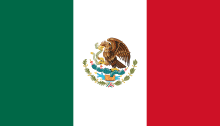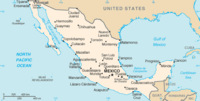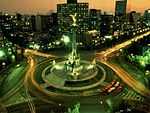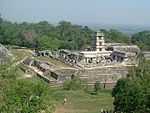Spanish 1/Chapter 1 (The Basics)
< Spanish 1Chapter 1 (The Basics)
Greetings
- Buenos días. - Good morning.
- Buenas noches. - Good night.
- Buenas tardes. - Good afternoon./Good evening.
- Hola. - Hello.
- ¿Cómo te llamas? - What is your name?
- Me llamo... - My name is...
- Encantado(a). - Delighted.
- Igualmente. - Equally. / Same here.
- Mucho gusto. - Pleased to meet you.
- Señor (Sr.) - sir, Mr.
- Señora (Sra.) - madam, Mrs.
- Señorita (Srta.) - miss, Ms.
- ¿Cómo estás? - How are you? (familiar)
- ¿Cómo está usted? - How are you? (formal)
- ¿Qué? - What?
- ¿Cómo le va? - How's it going?
- ¿Qué tal? - How are you?
- ¿Y tú? - And you? (familiar)
- ¿Y usted? - And you? (formal)
- bien - well
- más o menos - so so
- nada - nothing
- regular - regular, okay
- Lo siento - I am sorry
- Gracias. - Thank you.
- De nada. - You're welcome. / Not at all.
- A su servicio. - At your service.
- Adiós. - Good-bye.
- Chao. -Bye.
- Hasta luego. - See you later.
- Hasta mañana. - See you tomorrow.
- Nos vemos. - See you.
Note
Remember:
- in most countries, "ll" (double "L") is pronounced as "j"; "y" in Mexico.
- in Latin America the "Z" is pronounced as "s"; "th" in Spain.
- J is aspirated like H in English, while G tends to be rather guttural - from the throat
- letters in parentheses (a) are feminine, while those without (o) are masculine.
Grammar (Tú/Usted [Ud.] - Vosotros/Ustedes[Uds.])
In Spanish, there are several ways to say "you." We must differentiate between familiar/formal and singular/plural forms. Tú (singular) is used when talking to someone you know, such as family, friends, or pets. Usted (abbreviated Ud.) is used in formal events, such as talking to a teacher, someone who you don't know well, or a person who has a high title, such as a police officer, etc. In some Spanish-speaking countries (Venezuela and Colombia for example), usted can also be used for a close friend and tú is never used as a polite form. In the same way, vosotros (vosotras in feminine) is the plural of tú and ustedes (abbreviated uds.)) is the plural of usted.
| Singular | Plural | |
|---|---|---|
| Familiar | tú | vosotros/as (Spain) ustedes (Latin America) RAE |
| Formal | usted | ustedes |
Time Phrases
- Please read ¿Qué hora es?
- ¿Qué hora es? - What time is it?
- ¿A qué hora ....? - At what time ....?
- Es la una. - It's one o' clock.
- Son las dos. - It's two o' clock.
- Son las tres y cuarto. - It's 3:15.
- Son las cuatro y medio. - It's 4:30.
- Son las seis menos cuarto. - It's 5:45.
Numbers
- cero - zero (0)
- uno - one (1)
- dos - two (2)
- tres - three (3)
- cuatro - four (4)
- cinco - five (5)
- seis - six (6)
- siete - seven (7)
- ocho - eight (8)
- nueve - nine (9)
- diez - ten (10)
- once - eleven (11)
- doce - twelve (12)
- trece - thirteen (13)
- catorce - fourteen (14)
- quince - fifteen (15)
- dieciseis - sixteen (16)
- diecisiete - seventeen (17)
- dieciocho - eighteen (18)
- diecinueve - nineteen (19)
- veinte - twenty (20)
- veintiuno - twenty-one (21)
- treinta - thirty (30)
- treinta y uno - thirty-one (31)
- cuarenta - forty (40)
- cincuenta - fifty (50)
- sesenta - sixty (60)
- setenta - seventy (70)
- ochenta - eighty (80)
- noventa - ninety (90)
- cien - one hundred (100)
El cuerpo (The body)
- cabeza - head
- oreja - ear
- ojo - eye
- nariz - nose
- boca - mouth
- lengua - tongue
- cuello - neck
- brazo - arm
- pecho - chest
- mano - hand
- dedo - finger / toe
- estómago - stomach
- pierna - leg
- muslo - thigh
- pie - foot
- pelo - hair
- piel - skin
- músculo - muscle
- corazón - heart
- espalda - back
- rodilla - knee
- codo - elbow
School objects
- bolígrafo/pluma - pen
- carpeta - folder
- cuaderno - notebook
- estudiante - student
- hoja de papel - sheet of paper
- lápiz - pencil
- borrador - eraser
- libro - book
- profesor, profesora - teacher (male, female)
- sala de clases / aula - classroom
Grammar note
- El and La both mean the in Spanish. El is the masculine form and words that use el usually end in -o. La is the feminine form; most words that end in -a and all words that end in -ción are feminine. Some nouns can be either gender, such as estudiante, which can be used as el estudiante or la estudiante to mean the student. Examples of nouns contrary to the norms of gender are la mano and "la radio".
- Some feminine words, like agua, use the form El when in singular form, as it is considered hard to say la agua due to the glottal stop (hiatus).
- Some Spanish speakers use local dialects, for example, in central Mexico salón de clases is used instead of aula, and maestro(a) instead of profesor(a).
Calendar
- año - year
- día - day
- mes - month
- semana - week
- fin de la semana - weekend
- ¿Qué día es hoy? - What day is today?
- ¿Cúal es la fecha? - What is the date?
- Es el ... de ... - It's the ... of ...
- Es el primero de ... - It's the first of ...
- hoy - today
- ahora – now
- mañana - tomorrow
- en el futuro – in the future
- ayer - yesterday
Days
- lunes - Monday
- martes - Tuesday
- miércoles - Wednesday
- jueves - Thursday
- viernes - Friday
- sábado - Saturday
- domingo - Sunday
Months
- enero - January
- febrero - February
- marzo - March
- abril - April
- mayo - May
- junio - June
- julio - July
- agosto - August
- septiembre - September
- octubre - October
- noviembre - November
- diciembre - December
Cultural note
- The names of days in Spanish and many other European languages are always lowercase except at the beginning of a sentence.
- The Aztecs of Ancient Mexico developed a calendar. "The Aztec calendar stone, Mexica sun stone, Stone of the Sun (Spanish: Piedra del Sol), or Stone of the Five Eras, is a large monolithic sculpture that was excavated in the Zócalo, Mexico City's main square, on December 17, 1790.[1] It was discovered whilst Mexico City Cathedral was being repaired.[2] The stone is around 12 feet across and weighs about 24 tons.[3]."(taken from wikipedia)
[1] Florescano, Enrico (2006). National Narratives in Mexico. Nancy T. Hancock (trans.), Raul Velasquez (illus.) (English-language edition of Historia de las historias de la nación mexicana, ©2002 [Mexico City:Taurus] ed.). Norman: University of Oklahoma Press. ISBN 0-8061-3701-0. OCLC 62857841 . [2] a b Aztec Civilization [3] The Aztec Sun Stone
Other words
- ¿Cuántos(as)? - How many?
- en - in / on
- hay - there is, there are
- por favor - please
- ¿Cómo se dice...? - How does one say...? (How do you say...?)
- Se dice... - One says... (You say...)
Alphabet
- A - a
- B - be
- C - ce
- D - de
- E - eh
- F - efe
- G - ge
- H - hache
- I - ie
- J - hota
- K - ka
- L - ele
- M - eme
- N - ene
- Ñ - eñe
- O - oh
- P - pe
- Q - cu
- R - ere
- S - ese
- T - te
- U - u
- V - uve
- W - doble u
- X - equis
- Y - i griega/ye
- Z - zeta
- ¿Cómo se escribe ...? - How is ... spelled?
- Se escribe ... - It's spelled ...
- ¿Qué quiere decir ...? - What does ... mean?
- Quiere decir ... - It means ...
Country focus (México)

Mexico (Spanish: México) is a federal constitutional republic in North America. It is bordered on the north by the United States; on the south and west by the North Pacific Ocean; on the southeast by Guatemala, Belize, and the Caribbean Sea; and on the east by the Gulf of Mexico. Mexico is a federation comprising thirty-one states and a federal district, the capital Mexico City, whose metropolitan area is one of the world's most populous.

Covering almost 2.3 million square kilometers, Mexico is the fifth-largest country in the Americas by total area and the 14th largest independent nation in the world. With an estimated population of 111 million, it is the 11th most populous country and the most populous Spanish-speaking country in the world.
As a regional power and the only Latin American member of the Organization for Economic Co-operation and Development (OECD) since 1994, Mexico is firmly established as an upper middle-income country.
Mexico is the 12th largest economy in the world by GDP by purchasing power parity. The economy is strongly linked to those of its North American Free Trade Agreement (NAFTA) partners. Despite being considered an emerging world power, the uneven distribution of income and the increase in insecurity are issues of concern.
Mexican culture reflects the complexity of the country's history through the blending of pre-Hispanic civilizations and the culture of Spain, imparted during Spain's 300-year colonization of Mexico. Exogenous cultural elements mainly from the United States have been incorporated into Mexican culture. As was the case in most Latin American countries, when Mexico became an independent nation, it had to slowly create a national identity, being an ethnically diverse country in which, for the most part, the only connecting element amongst the newly independent inhabitants was Catholicism.

The Porfirian era (el Porfiriato), in the last quarter of the nineteenth century and the first decade of the twentieth century, was marked by economic progress and peace. After four decades of civil unrest and war, Mexico saw the development of philosophy and the arts, promoted by President Díaz himself. Since that time, though accentuated during the Mexican Revolution, cultural identity had its foundation in the mestizaje, of which the indigenous (i.e. Amerindian) element was the core. In light of the various ethnicities that formed the Mexican people, José Vasconcelos in his publication La Raza Cósmica (The Cosmic Race) (1925) defined Mexico to be the melting pot of all races (thus extending the definition of the mestizo) not only biologically but culturally as well. This exalting of mestizaje was a revolutionary idea that sharply contrasted with the idea of a superior pure race prevalent in Europe at the time.
Factbox:
- Official Language: Spanish
- Other Languages: 62 other Native languages, English
- Capital: Mexico City (Ciudad de México, México D.F.)
- Government: Democracy
- Area: 1,972,550 sq km (761,606 sq mi) (15th)
- Population: 111,211,789 (July 2010) (11th)
- Religion: Christianity 95% (mainly Catholic), Non-religious 2.5%, Buddhism 0.1%, other 2.4% (mainly traditional Mayan or Aztec beliefs)
- Human Development Index HDI : 0.854 (HIGH, 53rd) HDI List of Countries
- Independence: September 27, 1821
- Currency: Mexican pesos
